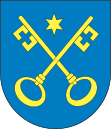Ciechanowiec
| Ciechanowiec | ||
|---|---|---|

|
|
|
| Basic data | ||
| State : | Poland | |
| Voivodeship : | Podlaskie | |
| Powiat : | Wysokomazowiecki | |
| Gmina : | Ciechanowiec | |
| Area : | 26.01 km² | |
| Geographic location : | 52 ° 40 ′ N , 22 ° 31 ′ E | |
| Residents : | 4750 (December 31, 2016) | |
| Postal code : | 18-230 | |
| Telephone code : | (+48) 86 | |
| License plate : | BWM | |
| Economy and Transport | ||
| Street : | Siemiatycze - Zambrów | |
| Kosów Lacki - Brańsk | ||
| Next international airport : | Warsaw | |
Ciechanowiec is a town in the powiat Wysokomazowiecki of the Podlaskie Voivodeship in Poland . It is the seat of the town-and-country municipality of the same name with around 8900 inhabitants.
geography
The city of Ciechanowiec is located in eastern Poland about 120 kilometers northeast of Warsaw and 65 kilometers southwest of Białystok .
The Nurzec River flows through the city and flows into the Bug about eight kilometers southeast .
history
The first fortification on the site of today's Ciechanowiec is proven for the 12th century. The fortification was destroyed by the Tatars in 1241. The town probably received town charter in the first third of the 15th century from the Mazovian Duke Jan I the Great ( Janusz I Wielki ). In 1434 the village of Ciechanowiec was first mentioned in a document. A Roman Catholic Church has existed since at least 1446.
In 1500 the name was mentioned as Czyechonowecz , in 1535 and 1536 the name of the city is Techonowcy . During the Second Northern War from 1655 to 1661 the city was badly damaged. During the Third Partition of Poland , Ciechanowiec became part of Prussia .
In 1807, Nowe Miasto (New Town) became part of the Duchy of Warsaw and Stare Miasto (Old Town) was added to Russia . With the dissolution of the Duchy of Warsaw, Nowe Miasto became part of the newly formed Congress Poland .
During the Polish-Soviet War , the Soviet Army marched through Ciechanowiec on its way to Warsaw. Many parts of the city were destroyed. After the Soviet army was defeated, Ciechanowiec came back to Poland and was reunited .
During the Second World War , the city became part of the Soviet Union in 1939 after the German-Soviet border and friendship treaty until the German invasion of the Soviet Union on June 22, 1941 . It became part of the Belarusian Soviet Socialist Republic . On August 2, 1944, the eastern part of Ciechanowiec was captured by the Red Army ; the entire city, which is separated by the Nurzec River, could not be captured until eleven days later.
After the war, the city became part of the People's Republic of Poland . In 1956 a hospital was established in the city.
local community
The city that gives it its name and 31 localities with a Schulzenamt belong to the urban and rural community of Ciechanowiec .
Partnerships
A partnership has existed with the Hessian city of Rosbach vor der Höhe since April 19, 1995 .
Culture and sights
Religions
The city had a large Jewish community until the Holocaust . The derelict synagogue is used today for cultural events.
Museums
The Krzysztof Kluk Agricultural Museum (Muzeum Rolnictwa im. Ks. Krzysztofa Kluka) was officially opened on July 5, 1964 and at that time had around 1,200 exhibits.
Buildings
- the remains of the castle
- the Church of the Holy Trinity
- the palace with park, part of the Agricultural Museum
- the monument to Jan Krzysztof Kluk
Economy and Infrastructure
traffic
The provincial road 690 (droga wojewodzka 690) leads through the city, which joins state road 63 in the northwest after about 25 kilometers . In a south-easterly direction, the 690 ends in Siemiatycze in Landesstraße 19 .
The provincial road 681 (droga wojewodzka 681) begins in Ciechanowiec and runs in a north-easterly direction. After about 25 kilometers, it reaches Brańsk , where it crosses national road 66 and continues towards Białystok .
The nearest international airport is Warsaw Frédéric Chopin Airport, about 130 kilometers to the southwest.
education
In the city there is the Nikolaus Kopernikus Elementary School (szkoła podstawowa im. Mikołaja Kopernika). There is also the Johannes Paul II secondary school in Ciechanowiec (gimnazjum im. Papieża Jana Pawła II). A vocational school ( Zasadnicza Szkoła Zawodowa ) and a school center ( Zespół Szkół Ogólnokształcących i Zawodowych im. J. Iwaszkiewicza ) are other educational institutions.
sons and daughters of the town
- Benjamin Mazar , born as Binyamin Zeev Maisler (1906–1995), Israeli historian and “father” of Israeli archeology.

